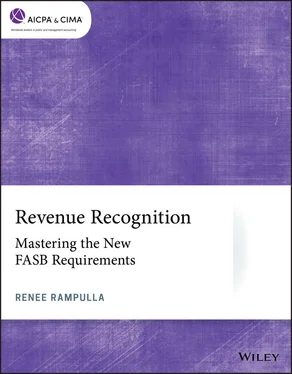In some contracts, payment terms limit an entity’s exposure to credit risk. For example, a customer may be required to pay a portion of the consideration promised in the contract before the entity transfers promised goods or services to the customer. In those cases, any consideration that will be received before the entity transfers promised goods or services to the customer would not be subject to credit risk.
An entity may limit its exposure to credit risk if it has the right to stop transferring additional goods or services to a customer in the event that the customer fails to pay consideration when it is due. In those cases, an entity should assess only the collectability of the consideration to which it will be entitled in exchange for the goods or services that will be transferred to the customer on the basis of the entity’s rights and customary business practices. Therefore, if the customer fails to perform as promised and, consequently, the entity would respond to the customer’s failure to perform by not transferring additional goods or services to the customer, the entity would not consider the likelihood of payment for the promised goods or services that will not be transferred under the contract.
 Key point
Key point
When seller financing is provided, an entity will need to consider a variety of factors when evaluating collectability of substantially all the considerations in which it will be entitled. Some of those factors might include the following:
An analysis of commercially available lending terms for similar transactions
The sufficiency of the down payment
The borrower creditworthiness
Historical experience of the seller in similar transactions with similar customers
An entity should not consider whether it can repossess an asset it transferred to a customer when assessing collectability
 Example 2-1 Mitigating credit risk
Example 2-1 Mitigating credit risk
To further explain when credit risk can be mitigated, consider the following:
Service provider ABC entity enters into a three-year service contract with new customer XYZ at the beginning of a calendar month.
XYZ has a very low credit quality.
The transaction price of the contract is $720, and $20 is due at the end of each month.
The standalone selling price of the monthly service is $20.
Both parties are subject to termination penalties if the contract is cancelled.
The ABC entity’s history with this class of customer indicates that while they cannot conclude it is probable that XYZ will pay the transaction price of $720, XYZ is expected to make the payments required under the contract for at least nine months. If, during the contract term, XYZ stops making the required payments, ABC entity’s customary business practice is to limit their credit risk by not transferring further services to XYZ and to pursue collection for the unpaid services.
Given the facts above, ABC entity needs to assess whether it is probable that they will collect substantially all of the consideration they will be entitled to in exchange for the services they transferred to XYZ. This would include their assessing their history with this class of customer as well as their business practice of stopping service in response to a customer’s nonpayment.
Based upon the above fact pattern:
It would not be probable that ABC entity will collect the entire transaction price ($720) because of XYZ’s low credit rating.
ABC’s exposure to credit risk is mitigated because they have the ability and intention (as evidenced by its customary business practice) to stop providing services when a customer does not pay the promised consideration for services provided when it is due.
ABC entity concludes that the contract meets the collectability criteria because it is probable that XYZ will pay substantially all of the consideration to which ABC entity is entitled for the services transfer to the XYZ (that is, for the services ABC entity will provide as long as XYZ continues to pay for the services provided).
ABC entity would then apply the remaining guidance in FASB ASC 606 to recognize revenue and only reassess the criteria if there is an indication of a significant change in facts or circumstances such as XYZ not making their required payments.
 Key point
Key point
An entity’s ability to repossess an asset transferred to a customer should not be considered when assessing the entity’s ability to mitigate its exposure to credit risk.
 Exercise 2-2 1
Exercise 2-2 1
The following example illustrates collectability of consideration as described in step 1:
Carl Construction, a real estate developer, enters into a contract for the sale of a building for $1 million. The customer, Neilson Enterprises, intends to open a restaurant in the building. The building is located in an area where new restaurants face high levels of competition and Neilson Enterprises has little experience in the restaurant industry. Neilson Enterprises pays a nonrefundable deposit of $50,000 at the inception of the contract and enters into a long-term financing agreement with Carl Construction for the remaining 95% of the promised consideration.
The financing agreement is provided on a nonrecourse basis, which means if Neilson Enterprises defaults, Carl Construction can repossess the building but cannot seek further compensation from Neilson Enterprises, even if the collateral does not cover the full value of the amount owed.
Does Carl Construction have a contract with Neilson Enterprises in accordance with FASB ASC 606? (As a reminder, in this example, Neilson Enterprises entered into the financing arrangement with Carl Construction with the intent of repaying the loan from the cash flow of the restaurant and has no other income or assets with which to repay the loan.)
 Exercise 2-3 2
Exercise 2-3 2
A1 Fitness, a health club, enters into a one-year membership with a Susan Jones, a customer with low credit quality. The transaction price of the contract is $120, and $10 is due at the beginning of each month. The standalone selling price of the monthly service is $10.
On the basis of Susan Jones’ credit history and in accordance with the customary business practice of A1 Fitness, Susan Jones is required to pay each month before AI Fitness provides her with access to their health club. In response to non-payment, A1 Fitness’ customary business practice is to stop providing service to the Susan Jones upon non-payment.
Has A1 Fitness met the criteria that collectability is probable?
 Exercise 2-4 3
Exercise 2-4 3
Big Pharma Inc. sells 1,000 units of a prescription drug to customer Jenco Corporation for promised consideration of $1 million. This is the first sale Big Pharma Inc. has made to customer Jenco Corporation, who is located in a new region, which is experiencing significant economic difficulty. Thus, Big Pharma Inc. does not expect to be able to collect the full amount of the promised consideration from Jenco Corporation. Despite the possibility of not collecting the full amount, Big Pharma Inc. expects the region’s economy to recover over the next two to three years and determines that a relationship with Jenco Corporation could help it forge relationships with other potential customers in the region.
Читать дальше

 Key point
Key point Example 2-1 Mitigating credit risk
Example 2-1 Mitigating credit risk Exercise 2-2 1
Exercise 2-2 1










